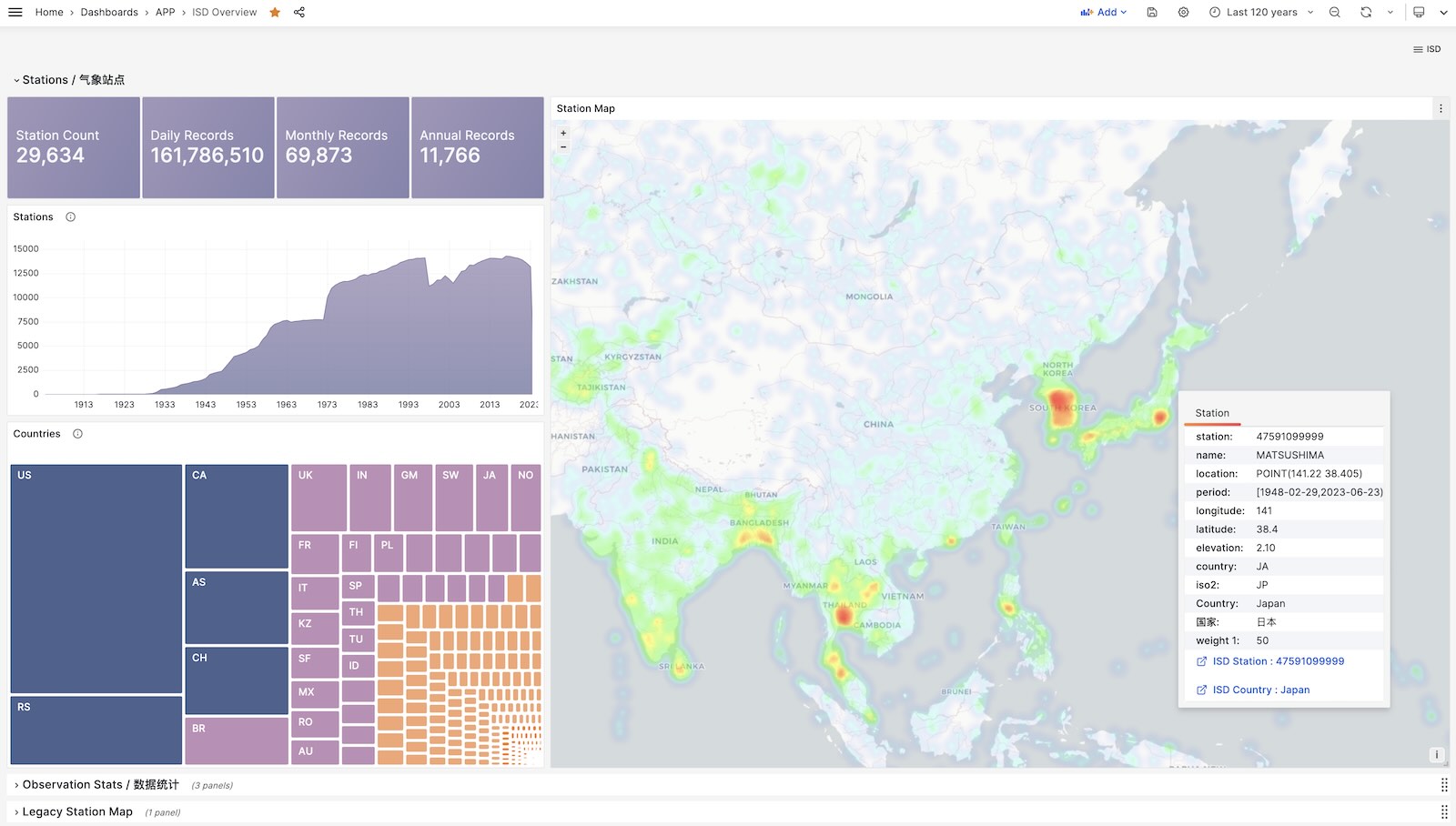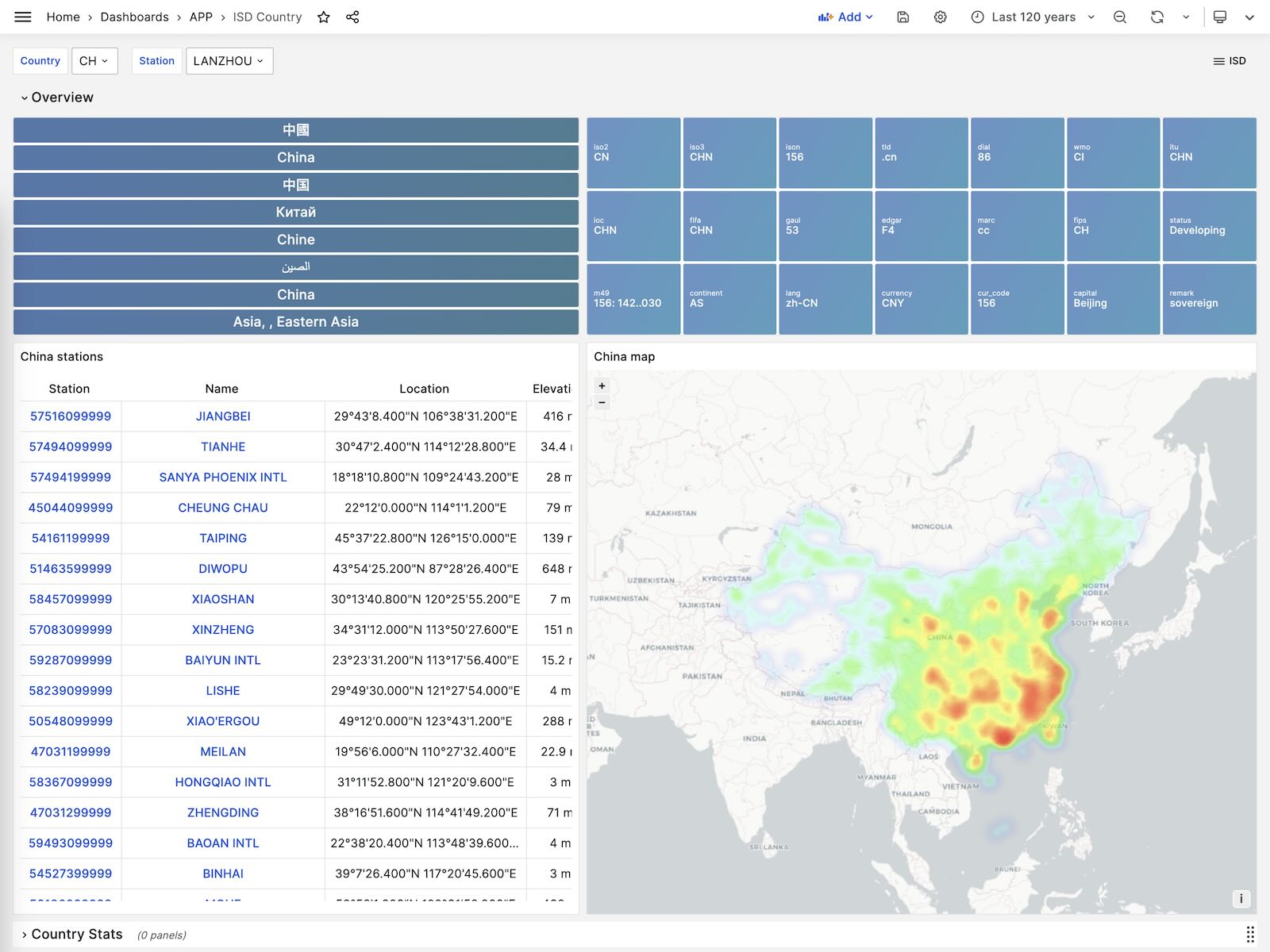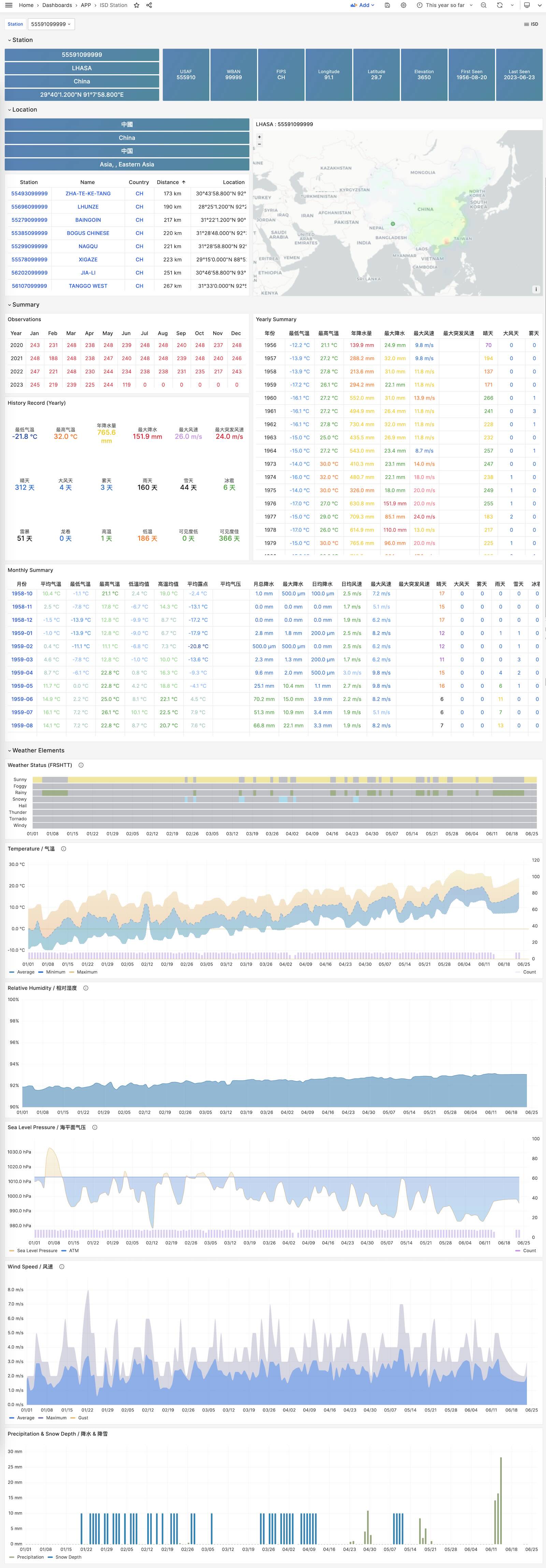NOAA ISD Station
Module:
Categories:
Including 30000 meteorology station, daily, sub-hourly observation records, from 1900-2023. https://github.com/Vonng/isd
It is recommended to use with Pigsty, the battery-included PostgreSQL distribution with Grafana & echarts for visualization. It will setup everything for your with make all;
Otherwise, you’ll have to provide your own PostgreSQL instance, and setup grafana dashboards manually.
Quick Start
Clone this repo
git clone https://github.com/Vonng/isd.git; cd isd; Prepare a PostgreSQL Instance
Export PGURL in your environment to specify the target postgres database:
# the default PGURL for pigsty's meta database, change that accordingly export PGURL=postgres://dbuser_dba:[email protected]:5432/meta?sslmode=disable psql "${PGURL}" -c 'SELECT 1' # check if connection is ok then init database schema with:
make sql # setup postgres schema on target database Get isd station metadata
The basic station metadata can be downloaded and loaded with:
make reload-station # equivalent to get-station + load-station Fetch and load isd.daily
To load isd.daily dataset, which is organized by yearly tarball files. You can download the raw data from noaa and parse with isd parser
make get-parser # download parser binary from github, you can just build with: make build make reload-daily # download and reload latest daily data and re-calculates monthly/yearly data Load Parsed Stable CSV Data
Or just load the pre-parsed stable part from GitHub. Which is well-formatted CSV that does not require an isd parser.
make get-stable # download stable isd.daily dataset from Github make load-stable # load downloaded stable isd.daily dataset into database More Data
There are two parts of isd datasets needs to be regularly updated: station metadata & isd.daily of the latest year, you can reload them with:
make reload # reload-station + reload-daily You can download and load isd.daily in a specific year with:
bin/get-daily 2022 # get daily observation summary of a specific year (1900-2023) bin/load-daily "${PGURL}" 2022 # load daily data of a specific year You can also download and load isd.hourly in a specific year with:
bin/get-hourly 2022 # get hourly observation record of a specific year (1900-2023) bin/load-hourly "${PGURL}" 2022 # load hourly data of a specific year Data
Dataset
There are four official datasets
| Dataset | Sample | Document | Comments |
|---|---|---|---|
| ISD Hourly | isd-hourly-sample.csv | isd-hourly-document.pdf | (Sub)Hour observation records |
| ISD Daily | isd-daily-sample.csv | isd-daily-format.txt | Daily summary |
| ISD Monthly | N/A | isd-gsom-document.pdf | Not used, Generate from isd.daily |
| ISD Yearly | N/A | isd-gsoy-document.pdf | Not used, Generate from isd.daily |
Daily Dataset
- Tarball size 2.8GB (until 2023-06-24)
- Table size 24GB, Index size 6GB, Total size in PostgreSQL = 30GB
- If timescaledb compression is used, it will be compressed to around 4.5GB
Hourly dataset
- Tarball size 117GB
- Table size 1TB+ , Index size 600GB+
Schema
- sql/1_schema.sql : isd schema
- sql/2_record.sql : daily, monthly, yearly table schema
- sql/3_hourly.sql : optional hourly data schema
- sql/4_data.sql : dict, map, country data
CREATE TABLE isd.station ( station VARCHAR(12) PRIMARY KEY, usaf VARCHAR(6) GENERATED ALWAYS AS (substring(station, 1, 6)) STORED, wban VARCHAR(5) GENERATED ALWAYS AS (substring(station, 7, 5)) STORED, name VARCHAR(32), country VARCHAR(2), province VARCHAR(2), icao VARCHAR(4), location GEOMETRY(POINT), longitude NUMERIC GENERATED ALWAYS AS (Round(ST_X(location)::NUMERIC, 6)) STORED, latitude NUMERIC GENERATED ALWAYS AS (Round(ST_Y(location)::NUMERIC, 6)) STORED, elevation NUMERIC, period daterange, begin_date DATE GENERATED ALWAYS AS (lower(period)) STORED, end_date DATE GENERATED ALWAYS AS (upper(period)) STORED ); CREATE TABLE IF NOT EXISTS isd.daily ( station VARCHAR(12) NOT NULL, -- station number 6USAF+5WBAN ts DATE NOT NULL, -- observation date -- temperature & dew point temp_mean NUMERIC(3, 1), -- mean temperature ℃ temp_min NUMERIC(3, 1), -- min temperature ℃ temp_max NUMERIC(3, 1), -- max temperature ℃ dewp_mean NUMERIC(3, 1), -- mean dew point ℃ -- pressure slp_mean NUMERIC(5, 1), -- sea level pressure (hPa) stp_mean NUMERIC(5, 1), -- station pressure (hPa) -- visible distance vis_mean NUMERIC(6), -- visible distance (m) -- wind speed wdsp_mean NUMERIC(4, 1), -- average wind speed (m/s) wdsp_max NUMERIC(4, 1), -- max wind speed (m/s) gust NUMERIC(4, 1), -- max wind gust (m/s) -- precipitation / snow depth prcp_mean NUMERIC(5, 1), -- precipitation (mm) prcp NUMERIC(5, 1), -- rectified precipitation (mm) sndp NuMERIC(5, 1), -- snow depth (mm) -- FRSHTT (Fog/Rain/Snow/Hail/Thunder/Tornado) is_foggy BOOLEAN, -- (F)og is_rainy BOOLEAN, -- (R)ain or Drizzle is_snowy BOOLEAN, -- (S)now or pellets is_hail BOOLEAN, -- (H)ail is_thunder BOOLEAN, -- (T)hunder is_tornado BOOLEAN, -- (T)ornado or Funnel Cloud -- record count temp_count SMALLINT, -- record count for temp dewp_count SMALLINT, -- record count for dew point slp_count SMALLINT, -- record count for sea level pressure stp_count SMALLINT, -- record count for station pressure wdsp_count SMALLINT, -- record count for wind speed visib_count SMALLINT, -- record count for visible distance -- temp marks temp_min_f BOOLEAN, -- aggregate min temperature temp_max_f BOOLEAN, -- aggregate max temperature prcp_flag CHAR, -- precipitation flag: ABCDEFGHI PRIMARY KEY (station, ts) ); -- PARTITION BY RANGE (ts); ISD Hourly
CREATE TABLE IF NOT EXISTS isd.hourly ( station VARCHAR(12) NOT NULL, -- station id ts TIMESTAMP NOT NULL, -- timestamp -- air temp NUMERIC(3, 1), -- [-93.2,+61.8] dewp NUMERIC(3, 1), -- [-98.2,+36.8] slp NUMERIC(5, 1), -- [8600,10900] stp NUMERIC(5, 1), -- [4500,10900] vis NUMERIC(6), -- [0,160000] -- wind wd_angle NUMERIC(3), -- [1,360] wd_speed NUMERIC(4, 1), -- [0,90] wd_gust NUMERIC(4, 1), -- [0,110] wd_code VARCHAR(1), -- code that denotes the character of the WIND-OBSERVATION. -- cloud cld_height NUMERIC(5), -- [0,22000] cld_code VARCHAR(2), -- cloud code -- water sndp NUMERIC(5, 1), -- mm snow prcp NUMERIC(5, 1), -- mm precipitation prcp_hour NUMERIC(2), -- precipitation duration in hour prcp_code VARCHAR(1), -- precipitation type code -- sky mw_code VARCHAR(2), -- manual weather observation code aw_code VARCHAR(2), -- auto weather observation code pw_code VARCHAR(1), -- weather code of past period of time pw_hour NUMERIC(2), -- duration of pw_code period -- misc -- remark TEXT, -- eqd TEXT, data JSONB -- extra data ) PARTITION BY RANGE (ts); Parser
There are two parsers: isdd and isdh, which takes noaa original yearly tarball as input, generate CSV as output (which could be directly consumed by PostgreSQL COPY command).
NAME isd -- Intergrated Surface Dataset Parser SYNOPSIS isd daily [-i <input|stdin>] [-o <output|stout>] [-v] isd hourly [-i <input|stdin>] [-o <output|stout>] [-v] [-d raw|ts-first|hour-first] DESCRIPTION The isd program takes noaa isd daily/hourly raw tarball data as input. and generate parsed data in csv format as output. Works in pipe mode cat data/daily/2023.tar.gz | bin/isd daily -v | psql ${PGURL} -AXtwqc "COPY isd.daily FROM STDIN CSV;" isd daily -v -i data/daily/2023.tar.gz | psql ${PGURL} -AXtwqc "COPY isd.daily FROM STDIN CSV;" isd hourly -v -i data/hourly/2023.tar.gz | psql ${PGURL} -AXtwqc "COPY isd.hourly FROM STDIN CSV;" OPTIONS -i <input> input file, stdin by default -o <output> output file, stdout by default -p <profpath> pprof file path, enable if specified -d de-duplicate rows for hourly dataset (raw, ts-first, hour-first) -v verbose mode -h print help UI
ISD Overview
Show all stations on a world map.
ISD Country
Show all stations among a country.
ISD Station
Visualize station metadata and daily/monthly/yearly summary
ISD Detail
Visualize hourly observation raw metrics.
License
Feedback
Was this page helpful?
Glad to hear it! Please tell us how we can improve.
Sorry to hear that. Please tell us how we can improve.



